Person-Centered Care for Joan Williams: A Nursing Home Case
VerifiedAdded on 2022/12/21
|12
|3086
|96
Essay
AI Summary
This essay delves into the concept of person-centered care within the context of nursing, using the case of Joan Williams, an 88-year-old woman recently admitted to a nursing home, as a focal point. The essay begins by introducing the importance of establishing relationships in nursing and the need for patient safety through person-centered care, which respects patient views and involves them in decision-making. Key concepts such as showing appreciation for patient values, providing information, ensuring comfort, dealing with anxiety, involving family and friends, and ensuring access to care are discussed. The principle of beneficence, emphasizing the nurse's duty to act in the patient's best interest, is also explored. Applying these principles to Joan's case, the essay suggests tailoring her environment to resemble her home and addressing her fears of making new friends. Furthermore, the essay employs an evidence-based approach to differentiate the roles of registered and enrolled nurses in providing person-centered care, highlighting the responsibilities and limitations of each role in ensuring patient safety and well-being.
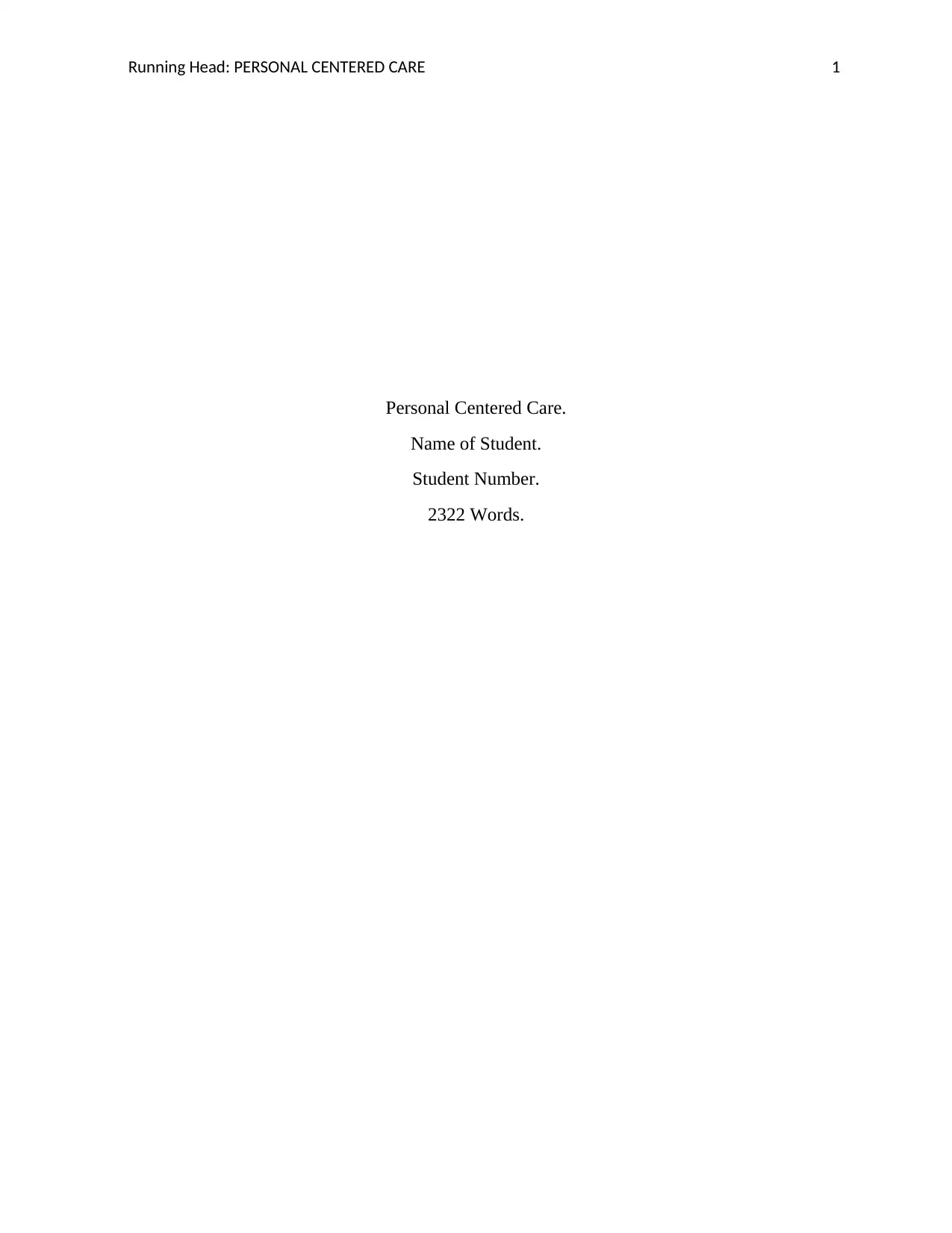
Running Head: PERSONAL CENTERED CARE 1
Personal Centered Care.
Name of Student.
Student Number.
2322 Words.
Personal Centered Care.
Name of Student.
Student Number.
2322 Words.
Paraphrase This Document
Need a fresh take? Get an instant paraphrase of this document with our AI Paraphraser
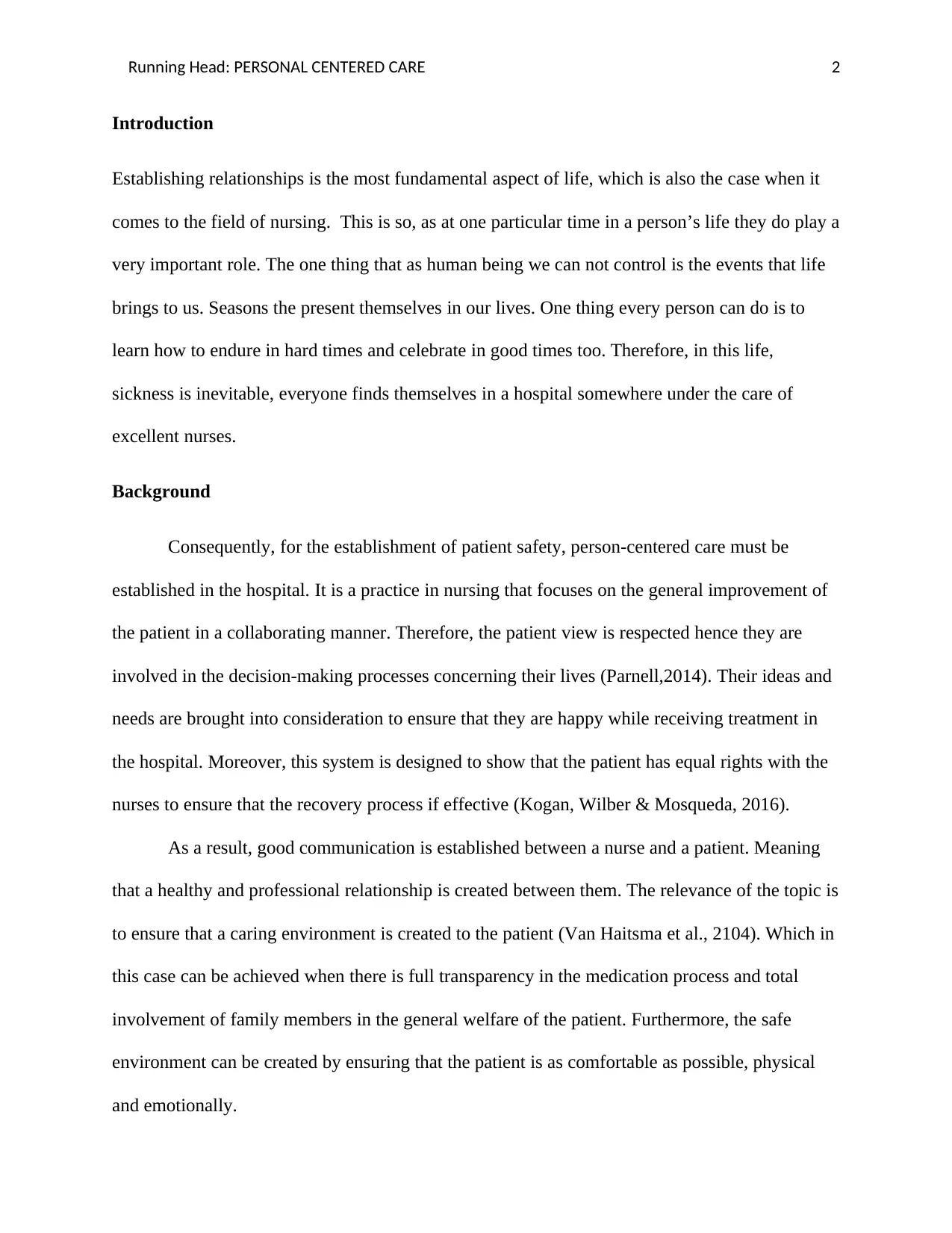
Running Head: PERSONAL CENTERED CARE 2
Introduction
Establishing relationships is the most fundamental aspect of life, which is also the case when it
comes to the field of nursing. This is so, as at one particular time in a person’s life they do play a
very important role. The one thing that as human being we can not control is the events that life
brings to us. Seasons the present themselves in our lives. One thing every person can do is to
learn how to endure in hard times and celebrate in good times too. Therefore, in this life,
sickness is inevitable, everyone finds themselves in a hospital somewhere under the care of
excellent nurses.
Background
Consequently, for the establishment of patient safety, person-centered care must be
established in the hospital. It is a practice in nursing that focuses on the general improvement of
the patient in a collaborating manner. Therefore, the patient view is respected hence they are
involved in the decision-making processes concerning their lives (Parnell,2014). Their ideas and
needs are brought into consideration to ensure that they are happy while receiving treatment in
the hospital. Moreover, this system is designed to show that the patient has equal rights with the
nurses to ensure that the recovery process if effective (Kogan, Wilber & Mosqueda, 2016).
As a result, good communication is established between a nurse and a patient. Meaning
that a healthy and professional relationship is created between them. The relevance of the topic is
to ensure that a caring environment is created to the patient (Van Haitsma et al., 2104). Which in
this case can be achieved when there is full transparency in the medication process and total
involvement of family members in the general welfare of the patient. Furthermore, the safe
environment can be created by ensuring that the patient is as comfortable as possible, physical
and emotionally.
Introduction
Establishing relationships is the most fundamental aspect of life, which is also the case when it
comes to the field of nursing. This is so, as at one particular time in a person’s life they do play a
very important role. The one thing that as human being we can not control is the events that life
brings to us. Seasons the present themselves in our lives. One thing every person can do is to
learn how to endure in hard times and celebrate in good times too. Therefore, in this life,
sickness is inevitable, everyone finds themselves in a hospital somewhere under the care of
excellent nurses.
Background
Consequently, for the establishment of patient safety, person-centered care must be
established in the hospital. It is a practice in nursing that focuses on the general improvement of
the patient in a collaborating manner. Therefore, the patient view is respected hence they are
involved in the decision-making processes concerning their lives (Parnell,2014). Their ideas and
needs are brought into consideration to ensure that they are happy while receiving treatment in
the hospital. Moreover, this system is designed to show that the patient has equal rights with the
nurses to ensure that the recovery process if effective (Kogan, Wilber & Mosqueda, 2016).
As a result, good communication is established between a nurse and a patient. Meaning
that a healthy and professional relationship is created between them. The relevance of the topic is
to ensure that a caring environment is created to the patient (Van Haitsma et al., 2104). Which in
this case can be achieved when there is full transparency in the medication process and total
involvement of family members in the general welfare of the patient. Furthermore, the safe
environment can be created by ensuring that the patient is as comfortable as possible, physical
and emotionally.
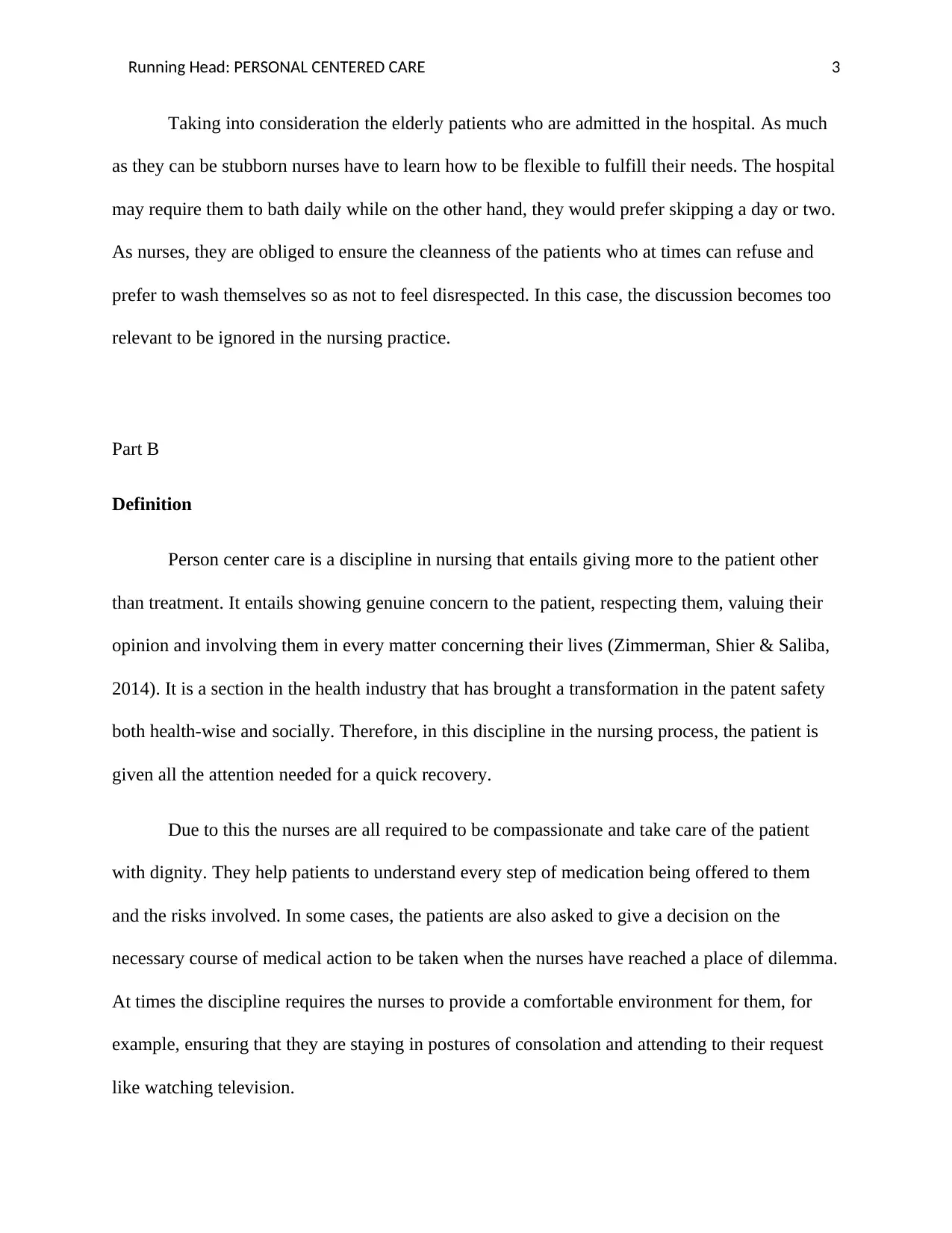
Running Head: PERSONAL CENTERED CARE 3
Taking into consideration the elderly patients who are admitted in the hospital. As much
as they can be stubborn nurses have to learn how to be flexible to fulfill their needs. The hospital
may require them to bath daily while on the other hand, they would prefer skipping a day or two.
As nurses, they are obliged to ensure the cleanness of the patients who at times can refuse and
prefer to wash themselves so as not to feel disrespected. In this case, the discussion becomes too
relevant to be ignored in the nursing practice.
Part B
Definition
Person center care is a discipline in nursing that entails giving more to the patient other
than treatment. It entails showing genuine concern to the patient, respecting them, valuing their
opinion and involving them in every matter concerning their lives (Zimmerman, Shier & Saliba,
2014). It is a section in the health industry that has brought a transformation in the patent safety
both health-wise and socially. Therefore, in this discipline in the nursing process, the patient is
given all the attention needed for a quick recovery.
Due to this the nurses are all required to be compassionate and take care of the patient
with dignity. They help patients to understand every step of medication being offered to them
and the risks involved. In some cases, the patients are also asked to give a decision on the
necessary course of medical action to be taken when the nurses have reached a place of dilemma.
At times the discipline requires the nurses to provide a comfortable environment for them, for
example, ensuring that they are staying in postures of consolation and attending to their request
like watching television.
Taking into consideration the elderly patients who are admitted in the hospital. As much
as they can be stubborn nurses have to learn how to be flexible to fulfill their needs. The hospital
may require them to bath daily while on the other hand, they would prefer skipping a day or two.
As nurses, they are obliged to ensure the cleanness of the patients who at times can refuse and
prefer to wash themselves so as not to feel disrespected. In this case, the discussion becomes too
relevant to be ignored in the nursing practice.
Part B
Definition
Person center care is a discipline in nursing that entails giving more to the patient other
than treatment. It entails showing genuine concern to the patient, respecting them, valuing their
opinion and involving them in every matter concerning their lives (Zimmerman, Shier & Saliba,
2014). It is a section in the health industry that has brought a transformation in the patent safety
both health-wise and socially. Therefore, in this discipline in the nursing process, the patient is
given all the attention needed for a quick recovery.
Due to this the nurses are all required to be compassionate and take care of the patient
with dignity. They help patients to understand every step of medication being offered to them
and the risks involved. In some cases, the patients are also asked to give a decision on the
necessary course of medical action to be taken when the nurses have reached a place of dilemma.
At times the discipline requires the nurses to provide a comfortable environment for them, for
example, ensuring that they are staying in postures of consolation and attending to their request
like watching television.
⊘ This is a preview!⊘
Do you want full access?
Subscribe today to unlock all pages.

Trusted by 1+ million students worldwide
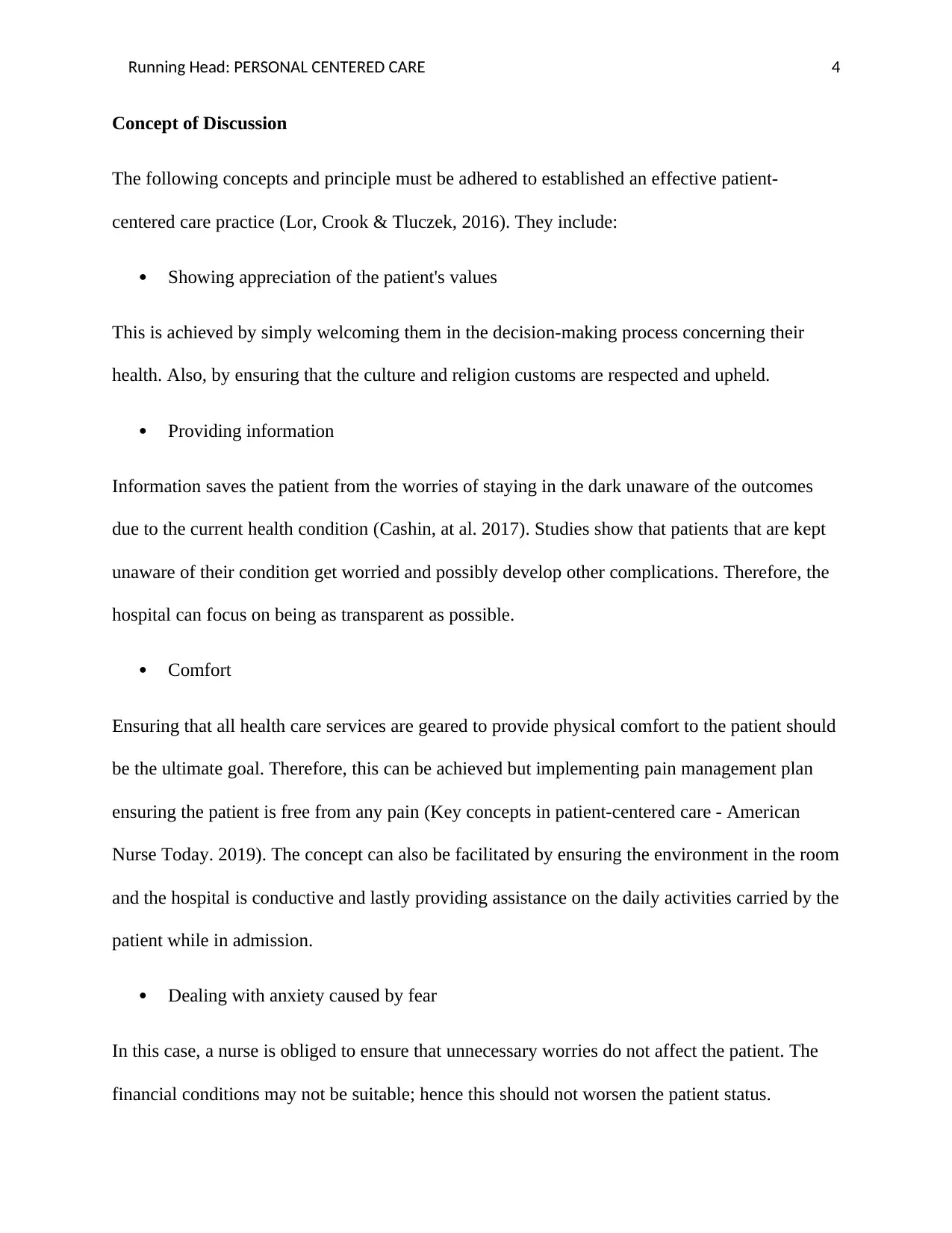
Running Head: PERSONAL CENTERED CARE 4
Concept of Discussion
The following concepts and principle must be adhered to established an effective patient-
centered care practice (Lor, Crook & Tluczek, 2016). They include:
Showing appreciation of the patient's values
This is achieved by simply welcoming them in the decision-making process concerning their
health. Also, by ensuring that the culture and religion customs are respected and upheld.
Providing information
Information saves the patient from the worries of staying in the dark unaware of the outcomes
due to the current health condition (Cashin, at al. 2017). Studies show that patients that are kept
unaware of their condition get worried and possibly develop other complications. Therefore, the
hospital can focus on being as transparent as possible.
Comfort
Ensuring that all health care services are geared to provide physical comfort to the patient should
be the ultimate goal. Therefore, this can be achieved but implementing pain management plan
ensuring the patient is free from any pain (Key concepts in patient-centered care - American
Nurse Today. 2019). The concept can also be facilitated by ensuring the environment in the room
and the hospital is conductive and lastly providing assistance on the daily activities carried by the
patient while in admission.
Dealing with anxiety caused by fear
In this case, a nurse is obliged to ensure that unnecessary worries do not affect the patient. The
financial conditions may not be suitable; hence this should not worsen the patient status.
Concept of Discussion
The following concepts and principle must be adhered to established an effective patient-
centered care practice (Lor, Crook & Tluczek, 2016). They include:
Showing appreciation of the patient's values
This is achieved by simply welcoming them in the decision-making process concerning their
health. Also, by ensuring that the culture and religion customs are respected and upheld.
Providing information
Information saves the patient from the worries of staying in the dark unaware of the outcomes
due to the current health condition (Cashin, at al. 2017). Studies show that patients that are kept
unaware of their condition get worried and possibly develop other complications. Therefore, the
hospital can focus on being as transparent as possible.
Comfort
Ensuring that all health care services are geared to provide physical comfort to the patient should
be the ultimate goal. Therefore, this can be achieved but implementing pain management plan
ensuring the patient is free from any pain (Key concepts in patient-centered care - American
Nurse Today. 2019). The concept can also be facilitated by ensuring the environment in the room
and the hospital is conductive and lastly providing assistance on the daily activities carried by the
patient while in admission.
Dealing with anxiety caused by fear
In this case, a nurse is obliged to ensure that unnecessary worries do not affect the patient. The
financial conditions may not be suitable; hence this should not worsen the patient status.
Paraphrase This Document
Need a fresh take? Get an instant paraphrase of this document with our AI Paraphraser
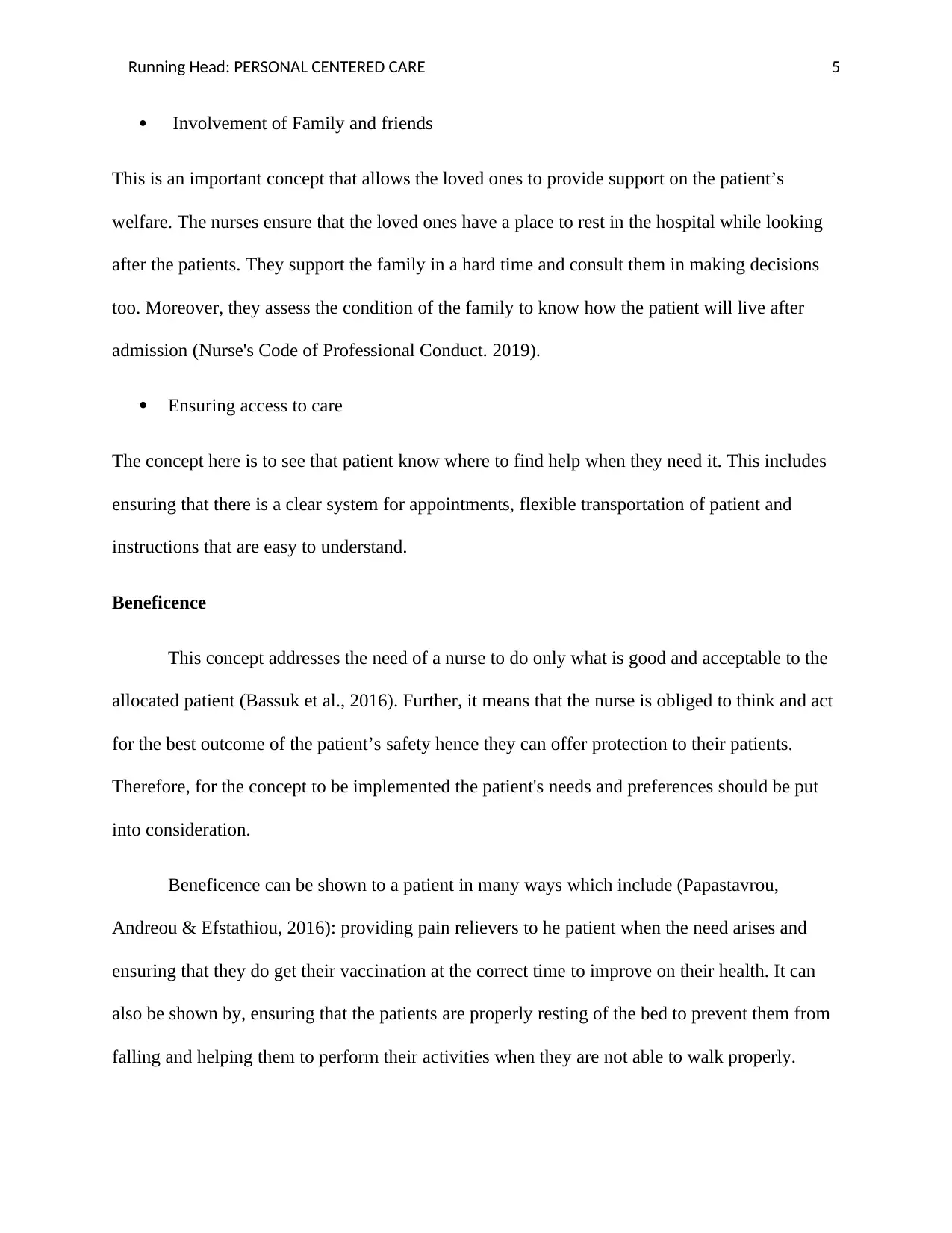
Running Head: PERSONAL CENTERED CARE 5
Involvement of Family and friends
This is an important concept that allows the loved ones to provide support on the patient’s
welfare. The nurses ensure that the loved ones have a place to rest in the hospital while looking
after the patients. They support the family in a hard time and consult them in making decisions
too. Moreover, they assess the condition of the family to know how the patient will live after
admission (Nurse's Code of Professional Conduct. 2019).
Ensuring access to care
The concept here is to see that patient know where to find help when they need it. This includes
ensuring that there is a clear system for appointments, flexible transportation of patient and
instructions that are easy to understand.
Beneficence
This concept addresses the need of a nurse to do only what is good and acceptable to the
allocated patient (Bassuk et al., 2016). Further, it means that the nurse is obliged to think and act
for the best outcome of the patient’s safety hence they can offer protection to their patients.
Therefore, for the concept to be implemented the patient's needs and preferences should be put
into consideration.
Beneficence can be shown to a patient in many ways which include (Papastavrou,
Andreou & Efstathiou, 2016): providing pain relievers to he patient when the need arises and
ensuring that they do get their vaccination at the correct time to improve on their health. It can
also be shown by, ensuring that the patients are properly resting of the bed to prevent them from
falling and helping them to perform their activities when they are not able to walk properly.
Involvement of Family and friends
This is an important concept that allows the loved ones to provide support on the patient’s
welfare. The nurses ensure that the loved ones have a place to rest in the hospital while looking
after the patients. They support the family in a hard time and consult them in making decisions
too. Moreover, they assess the condition of the family to know how the patient will live after
admission (Nurse's Code of Professional Conduct. 2019).
Ensuring access to care
The concept here is to see that patient know where to find help when they need it. This includes
ensuring that there is a clear system for appointments, flexible transportation of patient and
instructions that are easy to understand.
Beneficence
This concept addresses the need of a nurse to do only what is good and acceptable to the
allocated patient (Bassuk et al., 2016). Further, it means that the nurse is obliged to think and act
for the best outcome of the patient’s safety hence they can offer protection to their patients.
Therefore, for the concept to be implemented the patient's needs and preferences should be put
into consideration.
Beneficence can be shown to a patient in many ways which include (Papastavrou,
Andreou & Efstathiou, 2016): providing pain relievers to he patient when the need arises and
ensuring that they do get their vaccination at the correct time to improve on their health. It can
also be shown by, ensuring that the patients are properly resting of the bed to prevent them from
falling and helping them to perform their activities when they are not able to walk properly.

Running Head: PERSONAL CENTERED CARE 6
This way the nurses demonstrate a high standard of service delivery to the patients. They
show genuine concern, care, compassion and love to them. It goes beyond the obvious duties of a
nurse and helps to achieve the general objective of patient-centered care. This objective is to
ensure that there are good and working relationships in the entire hospital to ascertain better
service delivery (Nursing and Midwifery Board of Australia - Home. 2019).
Application
Likewise, in the scene of Joan’s medical condition, a nurse can be able to provide person-
centered care too. After careful assessment of Joan's personality and preference the allocated
nurse can choose to accept and appreciate the findings. Therefore, the nurse can decide to ensure
that she has a room specifically tailored to look like (Ignatavicius, & Workman,2015) her home.
The room should include a television set for her to watch till late at night as she was previously
doing. This way Joan will not feel bored in the hospital and will, in turn, cooperate with the
nurse.
Moreover, for comfort ability, the nurses should ensure that her room is not assessed by
other patient or teaching her on the essence of making friends in the hospital (Dahm, 2011).
Therefore, the nurse should help her to overcome the fear in her of making new friends. Hence,
the nurse should show her the need of having friends around her and how other patients help
each other to cope with their illness.
The nurse can also help her in doing her daily routines such as walking around the
compound to do some exercises, she can help her in cleaning her body too. Due to her extreme
scoliosis, the nurse can also ensure that she get her physical therapy well and have done her daily
This way the nurses demonstrate a high standard of service delivery to the patients. They
show genuine concern, care, compassion and love to them. It goes beyond the obvious duties of a
nurse and helps to achieve the general objective of patient-centered care. This objective is to
ensure that there are good and working relationships in the entire hospital to ascertain better
service delivery (Nursing and Midwifery Board of Australia - Home. 2019).
Application
Likewise, in the scene of Joan’s medical condition, a nurse can be able to provide person-
centered care too. After careful assessment of Joan's personality and preference the allocated
nurse can choose to accept and appreciate the findings. Therefore, the nurse can decide to ensure
that she has a room specifically tailored to look like (Ignatavicius, & Workman,2015) her home.
The room should include a television set for her to watch till late at night as she was previously
doing. This way Joan will not feel bored in the hospital and will, in turn, cooperate with the
nurse.
Moreover, for comfort ability, the nurses should ensure that her room is not assessed by
other patient or teaching her on the essence of making friends in the hospital (Dahm, 2011).
Therefore, the nurse should help her to overcome the fear in her of making new friends. Hence,
the nurse should show her the need of having friends around her and how other patients help
each other to cope with their illness.
The nurse can also help her in doing her daily routines such as walking around the
compound to do some exercises, she can help her in cleaning her body too. Due to her extreme
scoliosis, the nurse can also ensure that she get her physical therapy well and have done her daily
⊘ This is a preview!⊘
Do you want full access?
Subscribe today to unlock all pages.

Trusted by 1+ million students worldwide

Running Head: PERSONAL CENTERED CARE 7
routines well. On the other hand, the nurse can be joining Joan at night so that they can watch
television together to show a sense of compassion to her in this process.
Evidence-based approach
There is a very clear distinction between the duties offered by registered nurses and those
provided by an enrolled nurse. However, to clearly show this distinction the evidence-based
approach will relevantly serve the purpose as it is based on intensive research (Hunker, Gazza, &
Shellenbarger, 2014). It is mainly used to show the most efficient way of showing patient care.
Therefore, some stages need to be followed to ensure a proper difference is seen.
The first stage is looking and trying to find the question to ask. In this case, the question
will be formulated using the PICO format (McGowan et al., 2016). Therefore, do the duties of an
enrolled nurse differ from a registered nurse in ensuring that a person care discipline is
established? After the establishment, the task will be to find the solution to the question, which
forms the description (Epstein, R., & Street. 2019).
Furthermore, to get the relevant finds research needs to be done on the literature available
(Young et al., 2014). Therefore, a background review of the standards of practice on the enrolled
nurses and registered once outlines the foundation to the search. From the findings the enrolled
nurses are expected to:
Carry their activities while being guided by the registered nurses to ensure all work is
done appropriately.
Be responsible for every activity they do though supervised.
Take care, write and maintain reports of the patients including the medical histories.
routines well. On the other hand, the nurse can be joining Joan at night so that they can watch
television together to show a sense of compassion to her in this process.
Evidence-based approach
There is a very clear distinction between the duties offered by registered nurses and those
provided by an enrolled nurse. However, to clearly show this distinction the evidence-based
approach will relevantly serve the purpose as it is based on intensive research (Hunker, Gazza, &
Shellenbarger, 2014). It is mainly used to show the most efficient way of showing patient care.
Therefore, some stages need to be followed to ensure a proper difference is seen.
The first stage is looking and trying to find the question to ask. In this case, the question
will be formulated using the PICO format (McGowan et al., 2016). Therefore, do the duties of an
enrolled nurse differ from a registered nurse in ensuring that a person care discipline is
established? After the establishment, the task will be to find the solution to the question, which
forms the description (Epstein, R., & Street. 2019).
Furthermore, to get the relevant finds research needs to be done on the literature available
(Young et al., 2014). Therefore, a background review of the standards of practice on the enrolled
nurses and registered once outlines the foundation to the search. From the findings the enrolled
nurses are expected to:
Carry their activities while being guided by the registered nurses to ensure all work is
done appropriately.
Be responsible for every activity they do though supervised.
Take care, write and maintain reports of the patients including the medical histories.
Paraphrase This Document
Need a fresh take? Get an instant paraphrase of this document with our AI Paraphraser
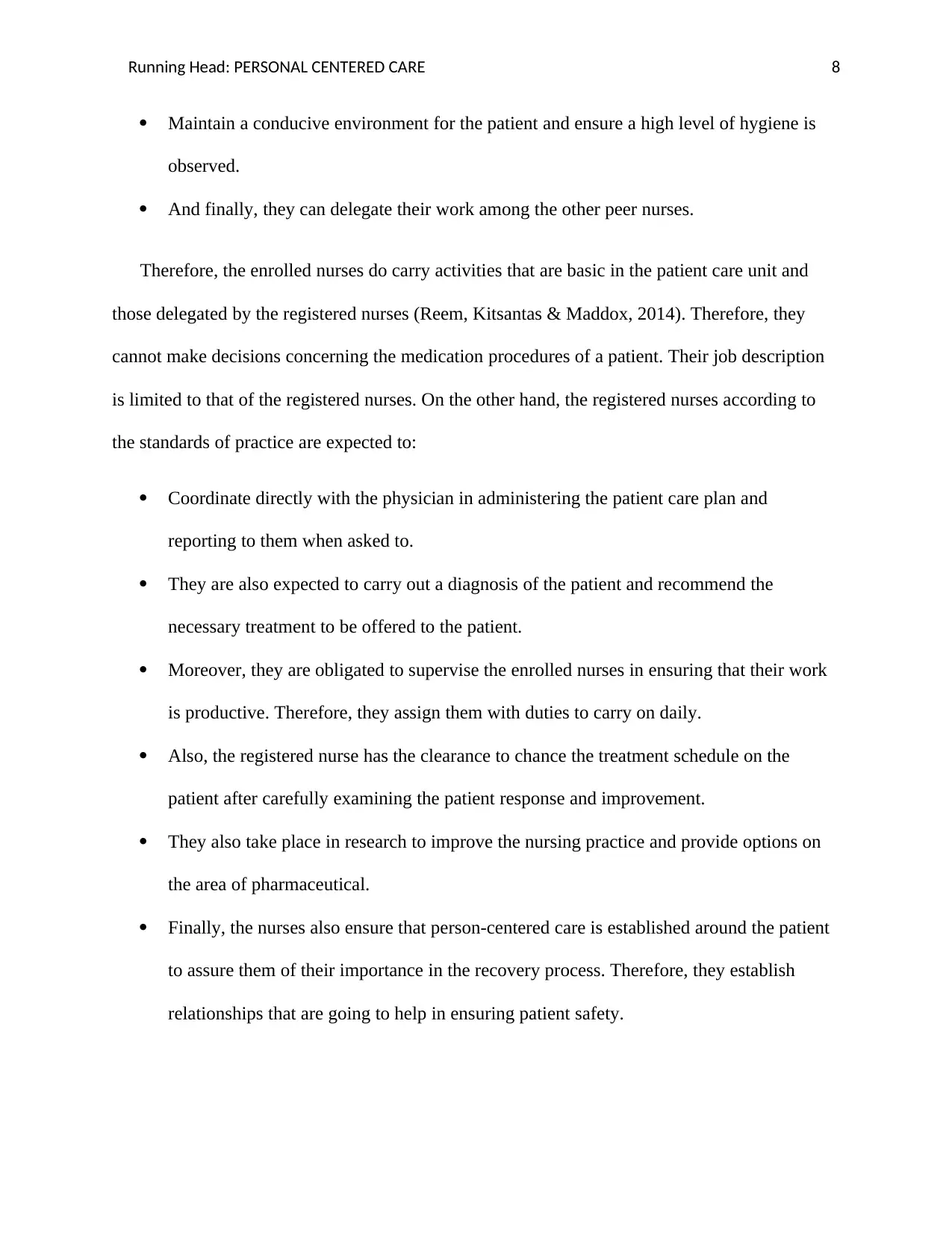
Running Head: PERSONAL CENTERED CARE 8
Maintain a conducive environment for the patient and ensure a high level of hygiene is
observed.
And finally, they can delegate their work among the other peer nurses.
Therefore, the enrolled nurses do carry activities that are basic in the patient care unit and
those delegated by the registered nurses (Reem, Kitsantas & Maddox, 2014). Therefore, they
cannot make decisions concerning the medication procedures of a patient. Their job description
is limited to that of the registered nurses. On the other hand, the registered nurses according to
the standards of practice are expected to:
Coordinate directly with the physician in administering the patient care plan and
reporting to them when asked to.
They are also expected to carry out a diagnosis of the patient and recommend the
necessary treatment to be offered to the patient.
Moreover, they are obligated to supervise the enrolled nurses in ensuring that their work
is productive. Therefore, they assign them with duties to carry on daily.
Also, the registered nurse has the clearance to chance the treatment schedule on the
patient after carefully examining the patient response and improvement.
They also take place in research to improve the nursing practice and provide options on
the area of pharmaceutical.
Finally, the nurses also ensure that person-centered care is established around the patient
to assure them of their importance in the recovery process. Therefore, they establish
relationships that are going to help in ensuring patient safety.
Maintain a conducive environment for the patient and ensure a high level of hygiene is
observed.
And finally, they can delegate their work among the other peer nurses.
Therefore, the enrolled nurses do carry activities that are basic in the patient care unit and
those delegated by the registered nurses (Reem, Kitsantas & Maddox, 2014). Therefore, they
cannot make decisions concerning the medication procedures of a patient. Their job description
is limited to that of the registered nurses. On the other hand, the registered nurses according to
the standards of practice are expected to:
Coordinate directly with the physician in administering the patient care plan and
reporting to them when asked to.
They are also expected to carry out a diagnosis of the patient and recommend the
necessary treatment to be offered to the patient.
Moreover, they are obligated to supervise the enrolled nurses in ensuring that their work
is productive. Therefore, they assign them with duties to carry on daily.
Also, the registered nurse has the clearance to chance the treatment schedule on the
patient after carefully examining the patient response and improvement.
They also take place in research to improve the nursing practice and provide options on
the area of pharmaceutical.
Finally, the nurses also ensure that person-centered care is established around the patient
to assure them of their importance in the recovery process. Therefore, they establish
relationships that are going to help in ensuring patient safety.

Running Head: PERSONAL CENTERED CARE 9
For the above roles, the registered nurses have a lot of responsibilities due to their vast studies
and experience in the field of nursing, unlike the enrolled nurses. They must have attained a
degree in their studies while the enrolled nurse needs to have only graduated with a diploma.
After the findings, the patients in the hospital also affirms that there is always a
difference between the two mentioned type of nurse. Therefore, the management tends to
distinguish between the two for effective service delivery. Finally, the result gotten for every
nurse in different ranking becomes commendable as it is geared towards the safety of the patient.
For the above roles, the registered nurses have a lot of responsibilities due to their vast studies
and experience in the field of nursing, unlike the enrolled nurses. They must have attained a
degree in their studies while the enrolled nurse needs to have only graduated with a diploma.
After the findings, the patients in the hospital also affirms that there is always a
difference between the two mentioned type of nurse. Therefore, the management tends to
distinguish between the two for effective service delivery. Finally, the result gotten for every
nurse in different ranking becomes commendable as it is geared towards the safety of the patient.
⊘ This is a preview!⊘
Do you want full access?
Subscribe today to unlock all pages.

Trusted by 1+ million students worldwide
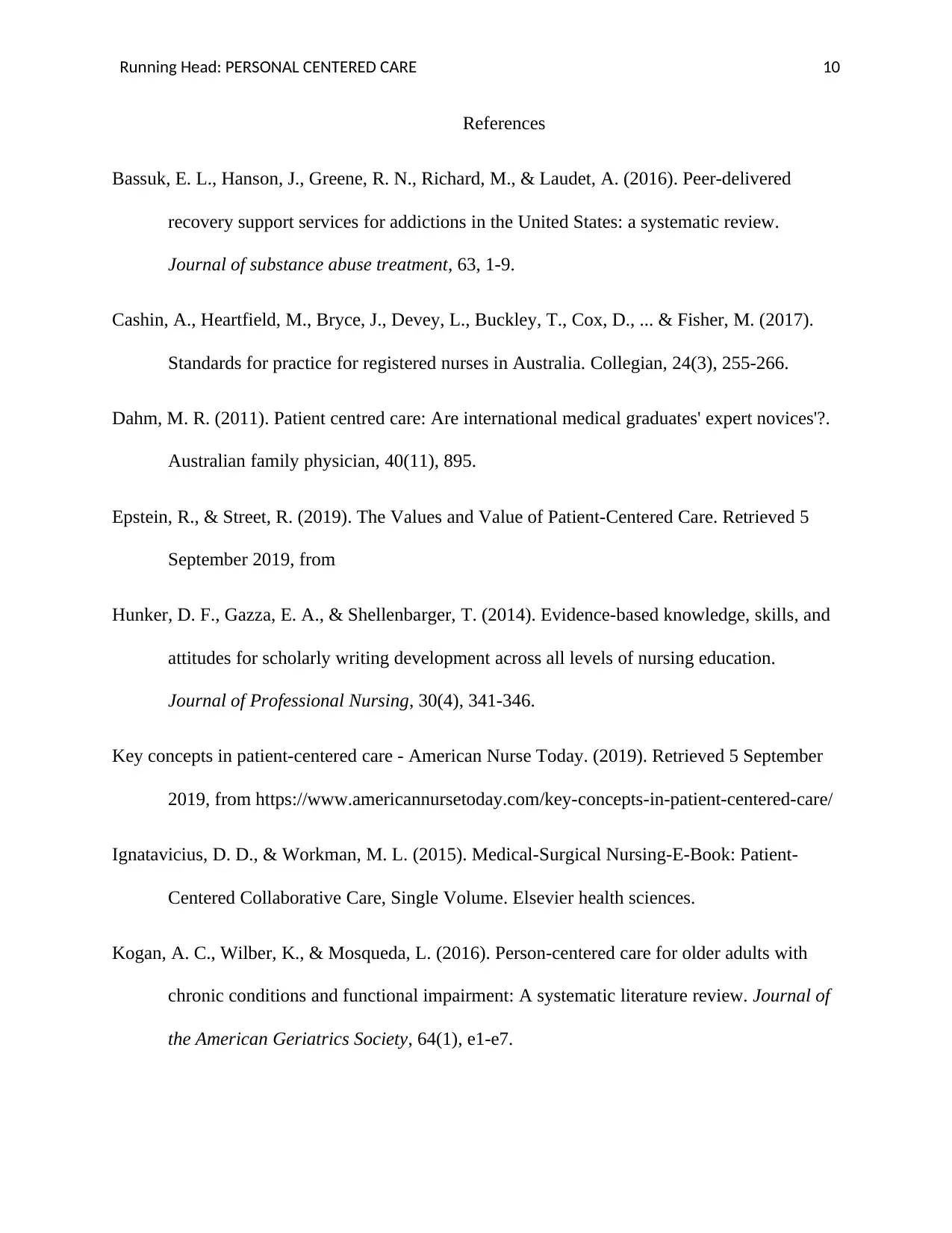
Running Head: PERSONAL CENTERED CARE 10
References
Bassuk, E. L., Hanson, J., Greene, R. N., Richard, M., & Laudet, A. (2016). Peer-delivered
recovery support services for addictions in the United States: a systematic review.
Journal of substance abuse treatment, 63, 1-9.
Cashin, A., Heartfield, M., Bryce, J., Devey, L., Buckley, T., Cox, D., ... & Fisher, M. (2017).
Standards for practice for registered nurses in Australia. Collegian, 24(3), 255-266.
Dahm, M. R. (2011). Patient centred care: Are international medical graduates' expert novices'?.
Australian family physician, 40(11), 895.
Epstein, R., & Street, R. (2019). The Values and Value of Patient-Centered Care. Retrieved 5
September 2019, from
Hunker, D. F., Gazza, E. A., & Shellenbarger, T. (2014). Evidence-based knowledge, skills, and
attitudes for scholarly writing development across all levels of nursing education.
Journal of Professional Nursing, 30(4), 341-346.
Key concepts in patient-centered care - American Nurse Today. (2019). Retrieved 5 September
2019, from https://www.americannursetoday.com/key-concepts-in-patient-centered-care/
Ignatavicius, D. D., & Workman, M. L. (2015). Medical-Surgical Nursing-E-Book: Patient-
Centered Collaborative Care, Single Volume. Elsevier health sciences.
Kogan, A. C., Wilber, K., & Mosqueda, L. (2016). Person‐centered care for older adults with
chronic conditions and functional impairment: A systematic literature review. Journal of
the American Geriatrics Society, 64(1), e1-e7.
References
Bassuk, E. L., Hanson, J., Greene, R. N., Richard, M., & Laudet, A. (2016). Peer-delivered
recovery support services for addictions in the United States: a systematic review.
Journal of substance abuse treatment, 63, 1-9.
Cashin, A., Heartfield, M., Bryce, J., Devey, L., Buckley, T., Cox, D., ... & Fisher, M. (2017).
Standards for practice for registered nurses in Australia. Collegian, 24(3), 255-266.
Dahm, M. R. (2011). Patient centred care: Are international medical graduates' expert novices'?.
Australian family physician, 40(11), 895.
Epstein, R., & Street, R. (2019). The Values and Value of Patient-Centered Care. Retrieved 5
September 2019, from
Hunker, D. F., Gazza, E. A., & Shellenbarger, T. (2014). Evidence-based knowledge, skills, and
attitudes for scholarly writing development across all levels of nursing education.
Journal of Professional Nursing, 30(4), 341-346.
Key concepts in patient-centered care - American Nurse Today. (2019). Retrieved 5 September
2019, from https://www.americannursetoday.com/key-concepts-in-patient-centered-care/
Ignatavicius, D. D., & Workman, M. L. (2015). Medical-Surgical Nursing-E-Book: Patient-
Centered Collaborative Care, Single Volume. Elsevier health sciences.
Kogan, A. C., Wilber, K., & Mosqueda, L. (2016). Person‐centered care for older adults with
chronic conditions and functional impairment: A systematic literature review. Journal of
the American Geriatrics Society, 64(1), e1-e7.
Paraphrase This Document
Need a fresh take? Get an instant paraphrase of this document with our AI Paraphraser
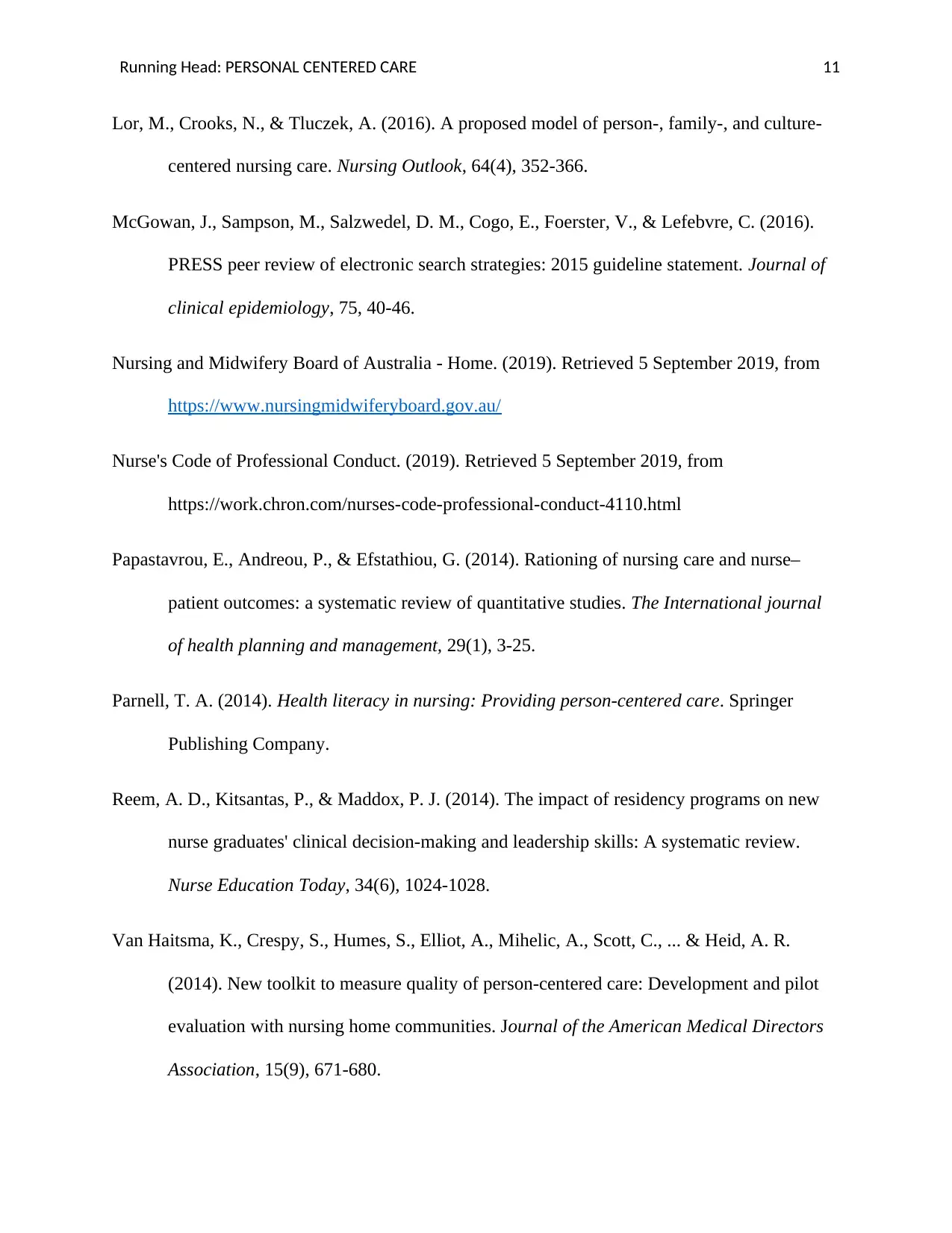
Running Head: PERSONAL CENTERED CARE 11
Lor, M., Crooks, N., & Tluczek, A. (2016). A proposed model of person-, family-, and culture-
centered nursing care. Nursing Outlook, 64(4), 352-366.
McGowan, J., Sampson, M., Salzwedel, D. M., Cogo, E., Foerster, V., & Lefebvre, C. (2016).
PRESS peer review of electronic search strategies: 2015 guideline statement. Journal of
clinical epidemiology, 75, 40-46.
Nursing and Midwifery Board of Australia - Home. (2019). Retrieved 5 September 2019, from
https://www.nursingmidwiferyboard.gov.au/
Nurse's Code of Professional Conduct. (2019). Retrieved 5 September 2019, from
https://work.chron.com/nurses-code-professional-conduct-4110.html
Papastavrou, E., Andreou, P., & Efstathiou, G. (2014). Rationing of nursing care and nurse–
patient outcomes: a systematic review of quantitative studies. The International journal
of health planning and management, 29(1), 3-25.
Parnell, T. A. (2014). Health literacy in nursing: Providing person-centered care. Springer
Publishing Company.
Reem, A. D., Kitsantas, P., & Maddox, P. J. (2014). The impact of residency programs on new
nurse graduates' clinical decision-making and leadership skills: A systematic review.
Nurse Education Today, 34(6), 1024-1028.
Van Haitsma, K., Crespy, S., Humes, S., Elliot, A., Mihelic, A., Scott, C., ... & Heid, A. R.
(2014). New toolkit to measure quality of person-centered care: Development and pilot
evaluation with nursing home communities. Journal of the American Medical Directors
Association, 15(9), 671-680.
Lor, M., Crooks, N., & Tluczek, A. (2016). A proposed model of person-, family-, and culture-
centered nursing care. Nursing Outlook, 64(4), 352-366.
McGowan, J., Sampson, M., Salzwedel, D. M., Cogo, E., Foerster, V., & Lefebvre, C. (2016).
PRESS peer review of electronic search strategies: 2015 guideline statement. Journal of
clinical epidemiology, 75, 40-46.
Nursing and Midwifery Board of Australia - Home. (2019). Retrieved 5 September 2019, from
https://www.nursingmidwiferyboard.gov.au/
Nurse's Code of Professional Conduct. (2019). Retrieved 5 September 2019, from
https://work.chron.com/nurses-code-professional-conduct-4110.html
Papastavrou, E., Andreou, P., & Efstathiou, G. (2014). Rationing of nursing care and nurse–
patient outcomes: a systematic review of quantitative studies. The International journal
of health planning and management, 29(1), 3-25.
Parnell, T. A. (2014). Health literacy in nursing: Providing person-centered care. Springer
Publishing Company.
Reem, A. D., Kitsantas, P., & Maddox, P. J. (2014). The impact of residency programs on new
nurse graduates' clinical decision-making and leadership skills: A systematic review.
Nurse Education Today, 34(6), 1024-1028.
Van Haitsma, K., Crespy, S., Humes, S., Elliot, A., Mihelic, A., Scott, C., ... & Heid, A. R.
(2014). New toolkit to measure quality of person-centered care: Development and pilot
evaluation with nursing home communities. Journal of the American Medical Directors
Association, 15(9), 671-680.
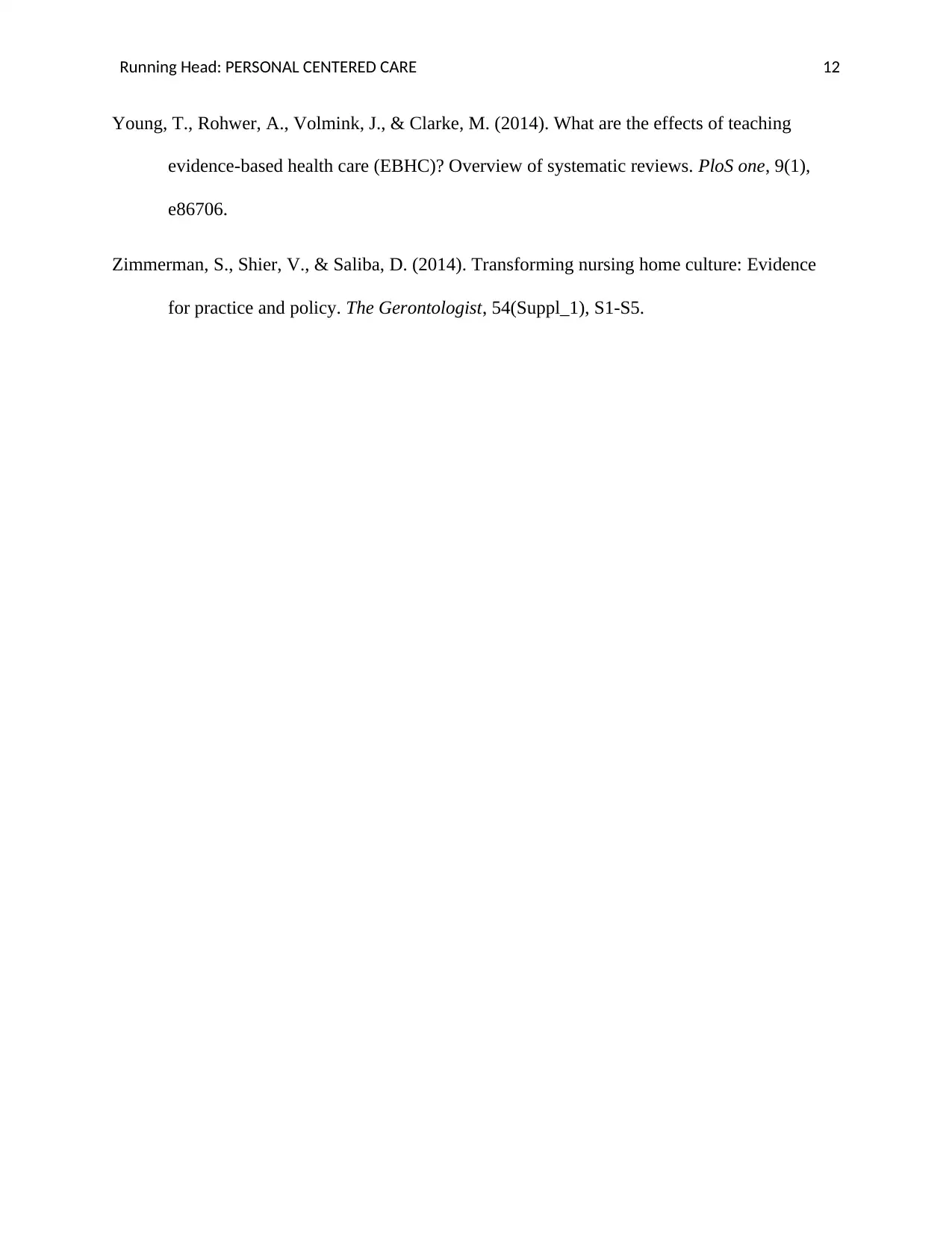
Running Head: PERSONAL CENTERED CARE 12
Young, T., Rohwer, A., Volmink, J., & Clarke, M. (2014). What are the effects of teaching
evidence-based health care (EBHC)? Overview of systematic reviews. PloS one, 9(1),
e86706.
Zimmerman, S., Shier, V., & Saliba, D. (2014). Transforming nursing home culture: Evidence
for practice and policy. The Gerontologist, 54(Suppl_1), S1-S5.
Young, T., Rohwer, A., Volmink, J., & Clarke, M. (2014). What are the effects of teaching
evidence-based health care (EBHC)? Overview of systematic reviews. PloS one, 9(1),
e86706.
Zimmerman, S., Shier, V., & Saliba, D. (2014). Transforming nursing home culture: Evidence
for practice and policy. The Gerontologist, 54(Suppl_1), S1-S5.
⊘ This is a preview!⊘
Do you want full access?
Subscribe today to unlock all pages.

Trusted by 1+ million students worldwide
1 out of 12
Related Documents
Your All-in-One AI-Powered Toolkit for Academic Success.
+13062052269
info@desklib.com
Available 24*7 on WhatsApp / Email
![[object Object]](/_next/static/media/star-bottom.7253800d.svg)
Unlock your academic potential
Copyright © 2020–2025 A2Z Services. All Rights Reserved. Developed and managed by ZUCOL.




